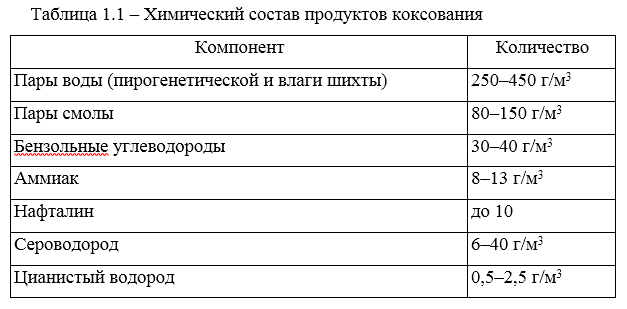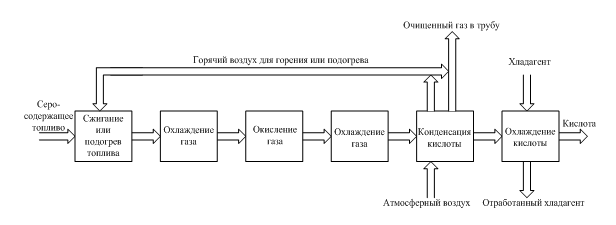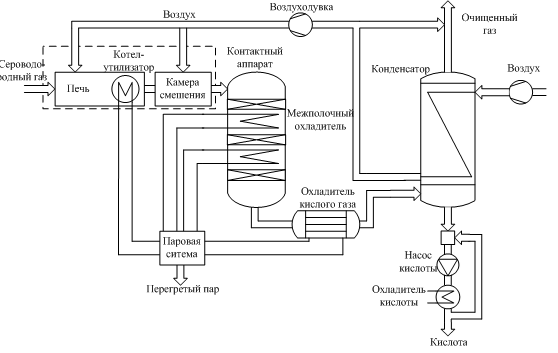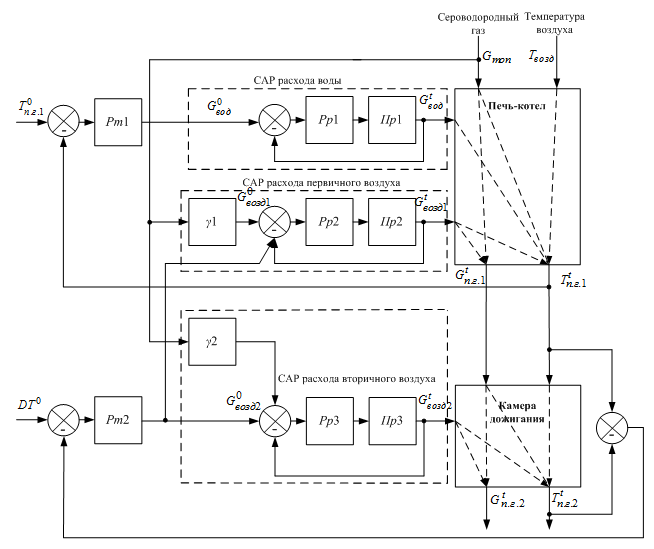Abstract
Content
- Introduction
- 1. Relevance of the topic
- 2. Purpose and objectives of the study, planned results
- 3. Main design and technological characteristics of the sulfuric acid production process
- 3.1 Process organization diagram and thermal control system
- 3.2 Purification of coke oven gas from hydrogen sulfide
- 4. Development of a structural diagram of the ACS
- Conclusions
- List of sources
Introduction
One of the reasons for the violation of the mode of combustion of hydrogen sulfide gas with fluctuations in its flow rate is the imperfection of the applied automatic control system (ACS). Therefore, an urgent task is to improve the existing ACS of the technological process for the production of sulfur dioxide in the scheme for the production of sulfuric acid by the method of wet catalysis. in a by-product coke plant in the direction of giving the system the property of "roughness" to the action of external disturbances and parametric uncertainty of the control object without loss of quality of manufactured products while meeting the requirements of the technological regulations.
1. Theme urgency
Issues related to environmental safety and improving the quality of products are now becoming increasingly important. At the coke-chemical enterprises of Donbass, the method of wet catalysis is used to produce sulfuric acid from hydrogen sulfide gas obtained as a result of cleaning coke oven gas. Under conditions of uneven loading of coke oven batteries, changes in the coking period and coal grade, fluctuations in the amount of processed hydrogen sulfide gas are observed, which leads to to a violation of the operating modes of the devices. A significant effect on the quality and quantity of produced sulfuric acid is exerted by the mode of conducting the process of obtaining sulfur dioxide, which consists in ensuring the set temperature and composition of the sulfur dioxide entering the contact apparatus, as well as reducing the amount of nitrogen oxides in the combustion products, deteriorating consumer properties of sulfuric acid.
2. Goal and tasks of the research
The aim of the work is to increase the efficiency of maintaining the required temperature mode of operation of the waste heat boiler,
through the development of an automatic control system that allows to reduce the amount of nitrogen oxides in sulfuric acid.
To achieve this goal, it is necessary to solve the following research tasks:
- To study the peculiarities of the technological process of the waste-heat boiler control in the scheme of sulfuric acid production by the wet catalysis method
and the existing control system in terms of the magnitude of fluctuations in the consumption of hydrogen sulfide gas, the quality of functioning and integration into a single enterprise management system. - Development of a mathematical model of a waste-heat boiler in the scheme for producing sulfur dioxide and conduct a study of the dynamic properties of the object along the control and disturbance channels.
- Development of an ACS by a waste-heat boiler that is invariant to the action of external disturbances in the specified ranges and parametric uncertainty of the control object.
- Development of a structure for the technical implementation of the ACS by a waste heat boiler based on modern industrial automation.
- Implementation of control algorithms based on the selected technical support of the ACS for the temperature regime of the waste heat boiler.
- Carrying out organizational and economic feasibility studies for the creation of an automatic control system for the temperature regime of the waste heat boiler.
- Formulation of requirements for occupational health and safety during installation and operation of ACS by a waste heat boiler.
Object of research : automatic control system of a waste heat boiler in the production of sulfuric acid.
Subject of research : investigation of the temperature regime of the waste heat boiler.
3. Main design and technological characteristics of the sulfuric acid production process
In the process of high-temperature coking of coal charges in the coke chamber, along with coke, volatile chemical products are formed, which are a complex inhomogeneous system, consisting of gaseous and vaporous substances, which are the product of thermal decomposition of coal. The main volatile products of high-temperature coking are: coke oven gas, pyrogenic water, naphthalene, ammonia, hydrogen sulfide (and other sulfur compounds), cyanide compounds, benzene hydrocarbons (crude benzene), high temperature coal tar, etc.

Table 1.1 - Chemical composition of coking products
A mixture of vapor and gaseous coking products leaving the coke chambers into the gas collectors forms the so-called direct coke oven gas. It contains the following quantities of chemical products (Table 1.1).
3.1 Process organization diagram and thermal control system.
At coke plants, sulfuric acid is obtained from sulfur-containing fuel (see Fig. 1.1). This scheme is used for cases when sulfur-containing fuel is obtained as a combustible compound mixture, for example, liquid sulfur, hydrogen sulfide or sulfur dioxide.

Figure 1.1 - Functional diagram of the technological chain for producing sulfuric acid from sulfur-containing fuel
The process organization diagram and thermal control system depend on the type of source fuel: whether sulfur-containing fuel has been obtained, which requires combustion to produce sulfur dioxide or is already sulfur dioxide. The yield of sulfur compounds depends on the content and types of sulfur in the coal. The main sulfur compound of coke oven gas is hydrogen sulfide, for example, at the factories of Donbass, its gas contains 16–26 g / m3 (up to 30–45 g / m3), and at factories in Western Siberia, 2–5 g / m3.
The composition and yield of coking chemical products largely depend on the heat engineering mode of operation of coke ovens and, in particular, on the temperature of the coking process, especially the temperature in the under-roof space of the coke chambers: the higher it is, the deeper the pyrolysis of volatile coking products goes.
With an increase in the coking temperature, the following changes in the yield and composition of chemical products occur:
- The gas yield increases, the hydrogen content increases, the methane content decreases significantly, in this regard, the density of the gas and the heat of its combustion decrease;
- The resin yield decreases, its density increases; the content of phenols in the resin is reduced, the content of naphthalene and substances insoluble in toluene ("free carbon") increases, the yield of oils decreases, and the yield of pitch increases;
- The yield of crude benzene distilled to 180 ° C and pure benzene increases with a simultaneous decrease in the toluene content, xylenes, solvents and unsaturated compounds;
- The yield of ammonia increases with increasing temperature and, having reached a certain maximum at a temperature of about 700 ° C, stabilizes, and then, with a further increase in temperature, it sharply decreases, since pyrolysis reactions proceed (for hydrogen and nitrogen). The moisture content in the charge slows down these reactions. Therefore, the higher the moisture content of the charge, the greater the yield of ammonia;
- The yield of hydrogen cyanide increases as a result of secondary reactions of ammonia with carbon of coke and carbon-containing gases (CO, CH4, etc.), flowing at high temperatures;
- The higher the yield of volatile substances in the charge and the higher the coking temperature, the more sulfur is converted into gas, tar and crude benzene.
3.2 Purification of coke oven gas from hydrogen sulfide
The obtained hydrogen sulphide gas is used for the production of sulfuric acid in wet catalysis plants. The process of obtaining sulfuric acid from hydrogen sulfide gas by the wet catalysis method is one of the main methods, used at domestic by-product coke plants. The technology for producing sulfuric acid consists in the sequential execution of stages (Fig. 1.2.).

Figure 1.2 - Scheme of sulfuric acid production from hydrogen sulfide by wet catalysis
The task of constructing a mathematical model of the technological process for obtaining sulfur dioxide is complicated by the fact that that the apparatus of the installation, as thermal objects, are described by distributed thermophysical parameters. To simplify the problem, it is proposed to use a model with lumped parameters. In this case, mass and energy are concentrated in several material points, and the physical quantities characterizing the processes occurring in the apparatus do not depend on the spatial coordinates and are only functions of time, i.e. it is believed that the parameters in the system are constant along the length of the end sections
4. Development of a structural diagram of the ACS
Apparatus of the technological process are connected in series, therefore fluctuations in the amount of incoming hydrogen sulfide gas lead to disruption of the operating modes of all subsequent apparatuses. The output of each apparatus is a disturbing effect for the next one, therefore, for the construction of a control system for the technological process of the production of sulfur dioxide, there cannot be the principle of open-loop control is applied separately. Since the disturbing effect can be measured and corrected based on the measurement results in the control algorithm and compensated for the deviation controlled variable, therefore it is advisable to apply the principle of disturbance control.
It should be noted that when controlling by disturbance, only the influence of only the disturbance that is measured is compensated. Other uncontrolled disturbances (for example, a change in the composition of hydrogen sulfide gas, the presence of scale and contamination of internal surfaces, etc.) lead to uncompensated deviations, as a result of which an error is observed at the output of the system. Combined control on based on compensation and feedback on the regulated coordinate, which will combine the merits of both principles: quick response to disturbances and control accuracy regardless of the nature of disturbances.
Based on the above, a generalized structural diagram of the ACS with a waste heat boiler is shown in Fig. 1.3.

Figure 1.3 - Block diagram of the ACS of a waste heat boiler
Two influences are compared at the controller input: the setpoint of the controlled variable and the feedback signal proportional to the actual value of this variable. For the temperature controller Pt1, the reference variable is the desired temperature T0p.g.1 of the primary combustion products, the temperature is controlled by changing the flow rate of the coolant Gtinlet by the automatic flow control system (ACS).
The schematic stage of the synthesis process involves the use of methods for constructing a logical circuit of a Moore automaton aimed to reduce the hardware costs of the target microcircuit. Such methods include trivial and layered implementations, structures with conversion of object codes, schemes on counters. Since modern digital design on chips FPGA is focused on the use of HDLs (mainly VHDL and Verilog), then the second step of the circuit design stage is the development An HDL program describing a Moore automaton and suitable for processing the corresponding CAD and immersion in a microcircuit.
In the structural diagram of the control system, it is proposed to use the regulation of the flow rate ratio "primary air - hydrogen sulfide gas" - through the stoichiometric coefficient and the ratio "secondary air - hydrogen sulphide gas" - through the stoichiometric coefficient. The introduction of ratio regulation will allow to ensure the invariance of the regulated temperatures and to disturbances in the consumption of the processed fuel.
Thus, the task of synthesizing an automatic control system for a waste-heat boiler and an afterburner consists in finding the structure and parameters of the regulators of the consumption of substances, temperature.
Conclusions
The analysis of the peculiarities of the technological process of obtaining sulfur dioxide in the scheme of production of sulfuric acid by the method of wet catalysis at coke plants.
Based on the analysis of the technological features of the sulfuric acid production process, the expediency of using the temperature control of combustion products has been substantiated at the outlet of the waste heat boiler based on feedback along the controlled coordinate, which will ensure quick response to the task and control accuracy regardless of the nature of disturbances.
Analysis of the simulation results confirms the compliance of the qualitative behavior of the ACS model with the main characteristics of the technological process under study.
References
- Amelin A.G. Sulfuric acid technology: [textbook] / A.G. Ameline. - M .: Chemistry, 1983 .-- 360 p.
- Bondar A.G. Mathematical modeling in the chemical industry / A.G. Cooper. - K .: Vishcha school, 1973 .-- 280 p.
- Wesselman S.G. Conditions of minimal formation of nitrogen oxides during the combustion of hydrogen sulfide gas / S.G. Wesselman, F.T. Bellin, V.G. Melikhov // Coke and Chemistry. - 1970. - No. 11. - S.42-45.
- Vtyurin V.A. Automated control systems for technological processes. Fundamentals of the process control system: [textbook for students of the specialty 220301 "Automation of technological processes and production"] / V.À. Utyurin. - SPb: SPbGLTA. 2006 .-- 152 p.
- Grebenyuk A.F. Features and principles of regulation of hydrogen sulfide gas combustion in wet catalysis installations / A.F. Grebenyuk, M.V. Pyankov, A.V. Milyutin, A.F. Chernysh // Coal Chemistry Journal. - 2007. - No. 3-4. - S. 41–44.
- Grebenyuk A.F. Development of a boiler-furnace scheme with a flexible mode of combustion of hydrogen sulfide gas / A.F. Grebenyuk, A.F. Chernysh, S.A. Salimanovich // Coal Chemical Journal. - 2008. - No. 3-4. - S. 55-60.
- Denisenko V.V. PID controllers: implementation issues. Part 1 / V.V. Denisenko // STA. - 2007. - No. 4. - S. 86-97.
- Denisenko V.V. PID controllers: implementation issues. Part 2 / V.V. Denisenko // STA. - 2008. - No. 1. - S. 86-99.
- Denisenko V.V. PID - controllers: principles of construction and modification. Part 1 / V.V. Denisenko // STA. - 2006. - No. 4. - S. 66-74.
- Denisenko V.V. PID - controllers: principles of construction and modification. Part 2 / V.V. Denisenko // STA. - 2007. - No. 1. - S. 78-88.
- Kazantsev E.I. Industrial ovens. Reference guide for calculation and design / E.I. Kazantsev. - M .: Metallurgy, 1975 .-- 368 p.
- Medvedev V.S. Control System Toolbox. MATLAB 5 for students / V.S. Medvedev, V.G. Potemkin. - M .: DIALOG-MEPhI, 1999 .-- 278 p.
- Mikheev M.A. Basics of heat transfer / M.A. Mikheeva, I.M. Mikheeva. - M .: Energiya, 1977 .-- 344 p.
- Basic processes and devices of chemical technology: Design manual / [G.S. Borisov, V.P. Brykov, Yu.I. Dytnersky and others]; ed. Yu.I. Dytnersky. - [2nd ed., Rev. and additional]. - M .: Chemistry, 1991 .-- 496 p.
- Sergeev A.P. On the issue of nitrogen oxides in sulfuric acid obtained by the method of wet catalysis / A.P. Sergeev // Coke and Chemistry. - 1957. - No. 7. - S. 41-43.
- Sergeev A.P. About the scheme of wet catalysis departments of the vacuum - carbonate desulfurization shop / A.P. Sergeev // Coke and Chemistry. - 1959. - No. 8. - S. 38-41.
- Tkachenko V.N. Analysis of the process of obtaining sulfuric acid from hydrogen sulfide in the system of complex automation of coal chemical production / V.N. Tkachenko, V.I. Bessarab, N.N. Chernyshev // "Practice and prospects for the development of partnership in higher education": Materials of the eighth scientific and practical seminar, Donetsk, April 17-20, 2007. In 3 volumes. Volume 3. - Donetsk: DonNTU, 2007. - ¹7. - S. 329-334.
- Tkachenko V.N. Development and research of a mathematical model of the technological process for the production of sulfuric acid / V.N. Tkachenko, N.N. Chernyshev // Science of the Donetsk National Technical University. Ser. calculating technology and automation. - Donetsk: DonNTU. - 2009. - VIP. 16 (148). - S. 22-29.
- Tkachenko V.N. System decomposition of the technological process of sulfuric acid production as an object of automation / V.N. Tkachenko, N.N. Chernyshev // Materials of the XIV International Conference on Automatic Control (Automation-2007), m. Sevastopol, 10-14 spring 2007. - Sevastopol: SNUYATAP, 2007. - Part 1. - S. 189-192.
- Chernyshev N.N. Model of the process of obtaining sulfurous anhydride in the space of states / N.N. Chernyshev // Science of the Donetsk National Technical University. Ser. numerical technology and automation, issue 20 (182). - Donetsk: DonNTU. - 2011, S. 82-87.
- Chernyshev N.N. Distributed system of automatic control of the hydrogen sulfide gas combustion unit / N.N. Chernyshev // Pratsi of the Luhansk report of the International Academy of informatization ¹1 (23). - Luhansk: Luhansk announcement of the International Academy of Informatization. - 2011, S. 89-95.
- Chernyshev N.N. Systemic decomposition of the sulfuric acid production process as an automation object. / N.N. Chernyshev // Science of the Donetsk National Technical University. Ser. numerical technology and automation. - Donetsk: DonNTU. - 2010. - VIP. 19 (153). - S. 27-33.
- Shuvalov V.V. Automation of production processes in the chemical industry / Shuvalov V.V., Ogadzhanov G.A., Golubyatnikov V.A. - M .: Chemistry, 1991 .-- 48
